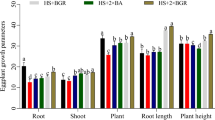Abstract
Bruguiera sexangula (Lour) Poir., a threatened mangrove tree, was inoculated with beneficial microbes in a nursery to assess any improvements in growth and biomass. From soil samples from the rhizosphere of B. sexangula in a mangrove forest in Panangadu of Kerala India, nitrogen-fixing bacteria Azotobacter chroococcum and Azospirillum brasilense were isolated. The phosphate-solubilising bacterium Bacillus megaterium and potassium-mobilizing bacteria Frateruria aurantia were also isolated and cultured on suitable media. Later, ripe propagules of B. sexangula were collected from matured trees and raised in sterilized soil bags (13 × 25 cm) containing sterilized soil and sand (2:1 ratio). The cultured beneficial microbes were propagated and used to inoculate the ripe propagules of B. sexangula and maintained in the nursery for 6 months. After 6 months, growth and biomass of the inoculated propagules were greater than for the uninoculated control propagules. Shoot length, number of leaves, stem girth and root length were also significantly greater than in the controls. This study showed that the mangrove-specific beneficial microbes influenced the growth of B. sexangula in the nursery and will help in the establishment of B. sexangula in degraded mangrove forests.


Similar content being viewed by others
References
Bashan Y, Holguin G (2002) Plant growth promoting bacteria: a potential tool for arid mangrove reforestation. Trees 16:159–166
Bashan Y, Moreno M, Troyo E (2000) Growth promotion of the sea water irrigated oil seed halophyte: Salicornia bigelovii inoculated with mangrove rhizosphere bacteria and halotolerent Azospirillum spp. Biol Fertil Soils 32:265–272
Chen Z, Ma S, Liu L (2008) Studies on phosphorus solubilizing activity of a strain of phosphobacteria isolated from chestnut type soil in China. Bioresour Technol 99:6702–6707
Diagne N, Karthikeyan A, Ngom M, Mathish NV, Franche C, Kumar KN, Laplaze L (2013) Use of Frankia and actinorhizal plants for degraded lands reclamation. Biomed Res Int. https://doi.org/10.1155/2013/948258
Duke N, Kathiresean K, Salmo III SG, Fernando ES, Peras JR, Sukandjo S, Miyagi T (2010) Bruguierasexangula, the IUCN red list of Threatened species 2010; eT178843A7624351. www.iucnredlist.org
Glick BR (1995) The enhancement of plant growth by free living bacteria. Can J Microbiol 41:109–117
Hu XF, Chen J, Guo JF (2006) Two phosphate and potassium solubilizing bacteria isolated from Tianmu mountain, Zhejang, China. World J Microbiol Biotechnol 22:983–990
Jackson ML (1973) Soil chemical analysis. Prentice Hall Publishers Private Ltd, Rimjhim publishing House, New Delhi, p 498
Jensen HL (1942) Nitrogen fixation in leguminous plants. II. Is symbiotic nitrogen fixation influence by Azotobater? Proc Linn Soc NSW 57:205–212
Karthikeyan A, Deeparaj B, Nepolean P (2009) Reforestation in Bauxite mine spoils with Casuarina equisetifolia Frost. and beneficial microbes. For Tree Livelihoods 19:153–165
Kathiresan K (2010) Importance of mangrove forests of India. J Coast Environ 1:11–25
Kathiresan K, Bingham BL (2001) Biology of mangroves and mangrove eco systems. Adv Mar Biol 40:81–251
Kathiresan K, Masilamani SM (2005) Evaluation of beneficial bacteria from mangrove soil. Bot Mar 49:86–88
Malik M, Fenshret R, Mentz O (2015) Economic valuation of mangroves for comparison with commercial aquaculture in South Sulwasi, Indonesia. Forests 6(30):3028–3044
Muthukumar T, Udaiyan K, Rajeshkannan V (2001) Response of neem (Azadirachta indica A. Juss) to indigenous arbuscular mycorrhizal fungi, phosphate solubilizing and symbiotic nitrogen fixing bacteria under tropical nursery conditions. Biol Fertil Soils 34:417–426
Pikovskaya RI (1948) Mobilization of phosphorus in soil in connection with vital activity of some microbial species. Microbiologia 17:362–370
Rajendran K, Devaraj P (2004) Biomass and nutrient distribution and their returns of Casuarina equisetifolia inoculated with bio fertilizers in farm land. Biomass Bioenergy 26:235–249
Ravikumar S, Kathiresan K, Ignatiammal TM, Selvam MB, Shanthy S (2004) Nitrogen fixing azotabacters from mangrove habitat and their utility as marine bio fertilizers. J Exp Mar Biol Ecol 312:5–17
Ravishankar T, Ramasubramanian R (2004) Manual on mangrove nursery techniques. M. S. Swaminathan Research foundation, Tharamani. Chennai (India): SBS Laser words Publishers Chennai India, p 48
Rodriguez Caceres EA (1982) Improved medium for isolation Azospirllum spp. Appl Environ Microbiol 44:990–991
Rodriguez H, Fraga R (1999) Phosphate solubilizing bacteria and their role in plant growth promotion. Biotechnol Adv 17:319–339
Rojas A, Holguin G, Glick BR, Bashan Y (2001) Synergism between Phyllobacteriumsp (N fixer) and Bacillus licheniformis (P – solubilizer) both from a semiarid mangrove rhizosphere. FEMS Microbiol Ecol 35:181–187
Sengupta V, Chaudhari S (1990) Halotolerant Rhizobium strains from mangrove swamps of the Ganges River Delta. Indian J Microbiol 30:483–484
Sengupta V, Chaudhari S (1991) Ecology of heterotrophic di nitrogen fixation in the rhizosphere of mangrove plant community at the Ganges river estuary in India. Oecologia 87:560–564
Sherman RE, Faheyn TJ, Howarth RW (1998) Soil plant interactions in a neo tropical mangrove forest: iron, phosphorus and sulfur dynamics. Oecologia 15:553–563
Sudhakar P, Chattapadhayay GN, Gangwar SK, Ghosh JK (2000) Effect of foliar application of Azotaobacter, Azospirillum and Beijerinckia on leaf yield and quality of mulberry (Morus alba). J Agric Sci 134:227–234
Toledo G, Bashan Y, Soeldner A (1995) Cyanobacteria and black mangroves in Northwestern Mexico: colorization and diurnal and second nitrogen fixation on aerial roots. Can J Microbiol 41:999–1011
Vazquez P, Holguin G, Puente ME, Cortes LA, Bashan Y (2000) Phosphates solubilizing microorganisms associated with the rhizosphere of mangroves in a semiarid coastal region. Biol Fertil Soils 30:460–468
Acknowledgement
The authors thank the Department of Science and Technology, New Delhi, Government of India for funding for this study (No. IF 110661).
Author information
Authors and Affiliations
Corresponding author
Additional information
Project funding: This study was funded by the Program of Department of Science and Technology, New Delhi, Government of India (No. IF 110661).
The online version is available at http://www.springerlink.com.
Corresponding editor: Zhu Hong.
Rights and permissions
About this article
Cite this article
Karthikeyan, A., Sivapriya, N.B. Responses of Bruguiera sexangula propagules to beneficial microbes in the nursery. J. For. Res. 29, 1093–1098 (2018). https://doi.org/10.1007/s11676-017-0502-8
Received:
Accepted:
Published:
Issue Date:
DOI: https://doi.org/10.1007/s11676-017-0502-8




